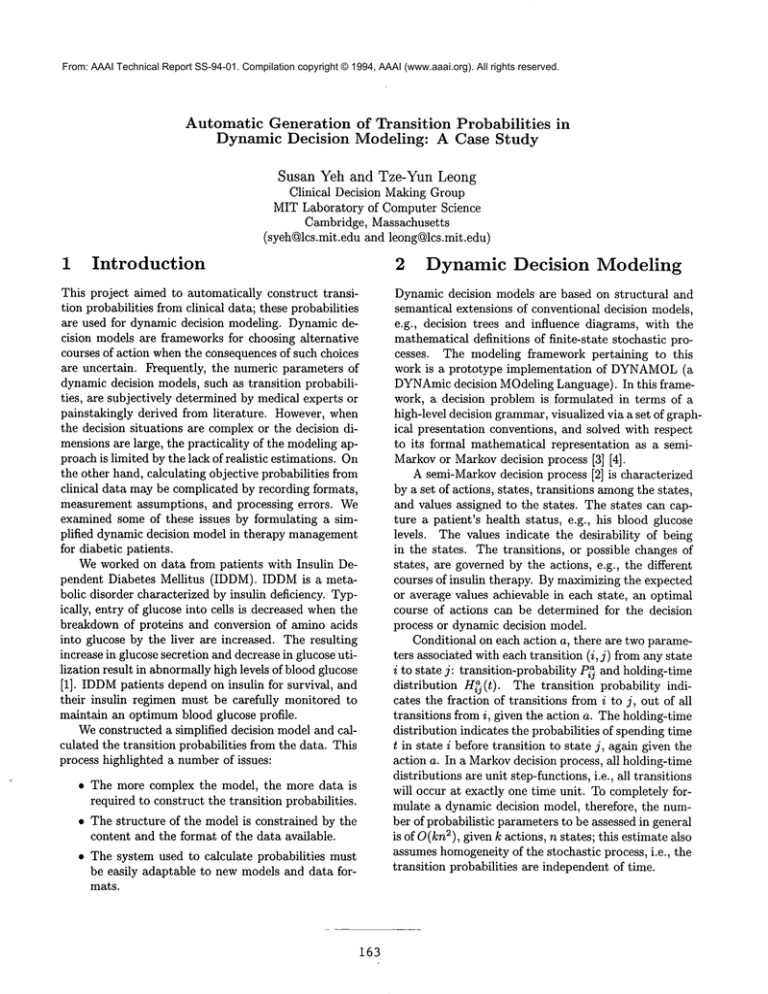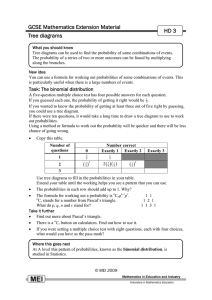
From: AAAI Technical Report SS-94-01. Compilation copyright © 1994, AAAI (www.aaai.org). All rights reserved.
Automatic Generation of Transition Probabilities
Dynamic Decision Modeling: A Case Study
in
SusanYehand Tze-YunLeong
Clinical Decision Making Group
MIT Laboratory of Computer Science
Cambridge, Massachusetts
(syeh@lcs.mit.edu and leong@lcs.mit.edu)
1
Introduction
2 Dynamic
This project aimed to automatically construct transition probabilities from clinical data; these probabilities
are used for dynamic decision modeling. Dynamic decision models are frameworks for choosing alternative
courses of action whenthe consequences of such choices
are uncertain. Frequently, the numeric parameters of
dynamic decision models, such as transition probabilities, are subjectively determined by medical experts or
painstakingly derived from literature.
However, when
the decision situations are complexor the decision dimensions are large, the practicality of the modelingapproach is limited by the lack of realistic estimations. On
the other hand, calculating objective probabilities from
clinical data may be complicated by recording formats,
measurement assumptions, and processing errors. We
examined some of these issues by formulating a simplified dynamic decision model in therapy management
for diabetic patients.
Weworked on data from patients with Insulin Dependent Diabetes Mellitus (IDDM). IDDMis a metabolic disorder characterized by insulin deficiency. Typically, entry of glucose into cells is decreased whenthe
breakdown of proteins and conversion of amino acids
into glucose by the liver are increased. The resulting
increase in glucose secretion and decrease in glucose utilization result in abnormallyhigh levels of blood glucose
[1]. IDDMpatients depend on insulin for survival, and
their insulin regimen must be carefully monitored to
maintain an optimumblood glucose profile.
Weconstructed a simplified decision model and calculated the transition probabilities from the data. This
process highlighted a number of issues:
¯ The more complex the model, the more data is
required to construct the transition probabilities.
¯ The structure of the model is constrained by the
content and the format of the data available.
¯ The system used to calculate probabilities must
be easily adaptable to new models and data formats.
163
Decision
Modeling
Dynamic decision models are based on structural and
semantical extensions of conventional decision models,
e.g., decision trees and influence diagrams, with the
mathematical definitions of finite-state stochastic processes. The modeling framework pertaining to this
work is a prototype implementation of DYNAMOL
(a
DYNAmic
decision MOdeling Language). In this framework, a decision problem is formulated in terms of a
high-level decision grammar,visualized via a set of graphical presentation conventions, and solved with respect
to its formal mathematical representation as a semiMarkovor Markovdecision process [3] [4].
A semi-Markovdecision process [2] is characterized
by a set of actions, states, transitions amongthe states,
and values assigned to the states. The states can capture a patient’s health status, e.g., his blood glucose
levels. The values indicate the desirability of being
in the states. The transitions, or possible changes of
states, are governed by the actions, e.g., the different
courses of insulin therapy. By maximizing the expected
or average values achievable in each state, an optimal
course of actions can be determined for the decision
process or dynamic decision model.
Conditional on each action a, there are two parameters associated with each transition (i, j) from any state
i to state j: transition-probability Pi~ and holding-time
distribution H~.(t). The transition probability indicates the fraction of transitions from i to j, out of all
transitions from i, given the action a. The holding-time
distribution indicates the probabilities of spending time
t in state i before transition to state j, again given the
action a. In a Markovdecision process, all holding-time
distributions are unit step-functions, i.e., all transitions
will occur at exactly one time unit. To completely formulate a dynamic decision model, therefore, the number of probabilistic parameters to be assessed in general
is of 0 (kn2), given k actions, n states; this estimate also
assumes homogeneityof the stochastic process, i.e., the
transition probabilities are independent of time.
3
3.1
Construction
Design
of Model
Issues
Whenformulating a decision model, one must balance
the need for a modelthat sufficiently represents the domain and one that is derivable from the data. If a model
is too complex, the data given maynot be sufficient for
generating the transition probabilities. Also, the states
and actions of a model must be observable from the
data. For example, in the given data set, very few patients recorded blood glucose (BG) measurements after
a meal. Thus, states must be based on BG measured
before a meal. Likewise, it is difficult to take into account exercise and diet, because very few observations
of these factors were recorded.
Wemodel the problem with a Markov process. This
is because with the assumption that transitions occur
at every meal, holding times are irrelevant. To further
simplify the problem, we do not account for long term
effects of the insulin or the patient’s states.
3.2
The
Decision
Model
A Markov state-transition
diagram of our dynamic decision model is shown in Fig. 1. There are two state
attribute variables, or dimensions on which a patient’s
state of health are defined:
¯ blood glucose (BG) level = {HIGH, NORMAL,
LOW}
¯ type of measurement
= {PRE-BREAKFAST,
PRE-LUNCH, PRE-SUPPER}
Transitions occur at every meal, i.e. if a patient is
at some PRE-LUNCH
state, she must make a transition to the PRE-SUPPER
state after any action. The
actions are changes (MORE,LESS, SAME)in regular
and NPHdosages. Ultralente (long-acting) insulin is ignored because it delivers a "basal" level of insulin and
is not changed very often [1]. Weconsider changes in
insulin dosage rather than absolute dosages because patients mayhave different insulin regimens, and insulin
dosages may vary widely across patients.
4
Generation of Probabilities
Working with the simplified decision model, we designed a program to compute the transition probabilities from the data set. Transition probabilities are generated by counting the number of times a transition
occurs for a particular state and action and dividing
that numberby the total number of transitions for that
164
Figure 1: State-Transition
Diagram
state-action combination. While this approach is simplistic, it is the most direct, easy to implement, and
without bias.
Weused a modular design to minimize the extra
work required if the data format or model changes.
There are four modules in the program, as shown in
Fig. 2.
Processing
iBu [ [
=- Sequence
: Statistics
:
Output
Figure 2: Structure of System
The Processing moduleis responsible for parsing the
data, such as converting the date and time to a number,
filtering out extraneous information, and converting the
data codes. The Build Sequence module takes the processed data and generates a sequence of states, transitions, and actions from the data. Messy data created
problems for this module. The data only reflects what
the patient recorded, not what she actually did. When
an insulin dosage is missing from the log, it is not clear
whether it was skipped or not recorded. The module
assumes that anything not recorded did not happen.
The Build Sequence notes when these gaps occur and
treat it as a decrease in insulin. The Statistics module
computesthe transition probabilities; it can include any
other procedures for generating statistical information
for these transitional probabilities. The Output module prints out the results and generates output files that
can be fed into a Markovsimulator.
Of the four modules, the Statistics and Output modules can be reused for different models and data formats. The Processing module has to be customized
for each data format, and the Build Sequence module
has to adapted to each new decision model. Great care
was taken to make sure that parts of the system are
reusable, but any changes in the underlying model or
data format will require customization.
5
Preliminary
ther Work
Results
and Fur-
Even using our simple model, there was not enough
data to generate all transition probabilities. Out of
the 243 transition-action combinations possible, 48 had
zero probabilities-the
combinations were not observable from the data. It was not possible to split the
data set into groups for multiple trials without creating more zero probability cases. Thus, without more
data, it is impossible to derive meaningful statistical
parameters for the resulting probabilities.
As mentioned earlier, gaps in the patient log can
complicate our analysis. For example, if a patient records
blood glucose measurements but does not record any
insulin taken, then the system will treat the insulin
dosage as zero. Then, the course of action taken at
every stage is (SAMEREG, SAMENPH) because all
insulin dosages are assumed to be zero. In our next implementation, we will take care of this problem by eliminating patient logs that do not record insulin dosages.
If opportunities permit, we plan to continue our
studies by working with other, more comprehensive diabetic databases and constructing alternate dynamic
decision models. More realistic models that take into
account the long term effects of the insulin regimenswill
be considered. Wewill attempt to verify our results by
one or more of the following ways: 1) by solving for the
optimal course of actions in the models and determining their admissibility; 2) by statistical analysis; and 3)
by consulting medical experts and/or clinical manuals.
165
6
Conclusion
This project provided some insights into the feasibility and requirements for the automated construction of
transition probabilities for dynamic decision modeling.
The primary difficulty we faced was insufficient data.
Wewere forced to keep the model simple and limit the
number of trials. This illuminates that fact that the
modeling process is very important, as an overly complex model will render calculation of the probabilities
difficult. On the other hand, an overly simplified model
that is constrained by the data available may not be
very useful. A medical expert should be consulted to
ensure that the model faithfully represents the domain.
Furthermore, a more consistent and complete recording
format will facilitate an analysis of patient logs. For
example, missed dosages can be noted on a log so that
they can be distinguished from dosages that were not
recorded. Finally, a probability generation system must
be easily customizable so that it can adapt to changes
in the decision models and/or the data formats.
7
Acknowledgments
The authors would like to thank Dr. Isaac Kohane
and Prof. Alvin Drake for their advice on the project,
and Prof. Peter Szolovits for guidance in defining the
project. This research was supported by the National
Science Foundation Graduate Fellowship, USAFRome
Laboratory and DARPAunder contract F30602-91-C0018, and by National Institutes of Health Grant No.
R01 LM04493from the National Library of Medicine.
References
[1]Kenneth L.
Becker, editor. Principles and Practice
of Endocrinology and Metabolism. J.B. Lippincott
Company, Grand Rapids, 1990.
[2] Ronald A. Howard. Dynamic Probabilistic Systems,
volume 1 2. John Wiley and Sons, NewYork, 1971.
[3]Tze-Yun
Leong. Dynamic decision modeling in
medicine: A critique of existing formalisms. In Proceedings o/the Seventeenth Annual Symposium on
Computer Applications in Medical Care, pages 478484. IEEE, November 1993.
[4]Tze-Yun
Leong. Dynamic Decision Making under
Uncertainty.
PhD thesis, MIT, Cambridge, MA,
1994. In preparation.






